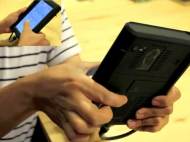Touché sensing technique – enhancing capacitive touch sensing
 A new sensing technique developed by a team at Disney Research, Pittsburgh, and Carnegie Mellon University (CMU) could enhance current capacitive touch sensing used for information interaction by enabling detection of more complex gestures. Named Touché, the new method monitors capacitive signals across a broad range of frequencies instead sensing electrical signals at a single frequency.
A new sensing technique developed by a team at Disney Research, Pittsburgh, and Carnegie Mellon University (CMU) could enhance current capacitive touch sensing used for information interaction by enabling detection of more complex gestures. Named Touché, the new method monitors capacitive signals across a broad range of frequencies instead sensing electrical signals at a single frequency.
Both Touché and smartphone touchscreens are based on the phenomenon known as capacitive coupling. By monitoring a range of signal frequencies, however, Touché can derive much more information. Different body tissues have different capacitive properties, so monitoring a range of frequencies can detect a number of different paths that the electrical charge takes through the body.
Swept Frequency Capacitive Sensing (SFCS) enables detection of a “touch event” while recognizing complex configurations of the hand or body involved into touching. That ability enables the SFCS to enhance everyday objects by using just a single sensing electrode. Making sense of all of that SFCS information, however, requires analyzing hundreds of data points. As microprocessors have become faster and less expensive, it now is feasible to use SFCS in touch interfaces.
“Signal frequency sweeps have been used for decades in wireless communication, but as far as we know, nobody previously has attempted to apply this technique to touch interaction,” said Ivan Poupyrev, senior research scientist at Disney Research, Pittsburgh. “Yet, in our laboratory experiments, we were able to enhance a broad variety of objects with high-fidelity touch sensitivity. When combined with gesture recognition techniques, Touché demonstrated recognition rates approaching 100 percent. That suggests it could immediately be used to create new and exciting ways for people to interact with objects and the world at large.”
In addition to Poupyrev, the research team included Chris Harrison, a Ph.D. student in Carnegie Mellon’s Human-Computer Interaction Institute, and Munehiko Sato, a Disney intern and a Ph.D. student in engineering at the University of Tokyo. Disney Research, Pittsburgh, is located on CMU’s campus in the Robert Mehrabian Collaborative Innovation Center.
Touché proved to be useful in various demonstrated applications. Aside adding new gestures with multiple finger detection on existing devices and objects, the researchers were able to monitor body gestures, such as touching fingers, grasping hands and covering ears by having subjects wear electrodes similar to wristwatches on both arms. They also showed that a single electrode attached to any water vessel could detect a number of gestures, such as fingertip submerged, hand submerged and hand on bottom. According to researchers, sensing touch in liquids might be particularly suited to toys, games and food appliances.
For more information, you can read the paper named: “Touché: Enhancing Touch Interaction on Humans, Screens, Liquids, and Everyday Objects” (PDF, 10Mb).









Leave your response!